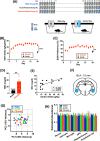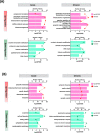Genome-wide transcriptomics of the amygdala reveals similar oligodendrocyte-related responses to acute and chronic alcohol drinking in female mice
- PMID: 36371333
- PMCID: PMC9653459
- DOI: 10.1038/s41398-022-02231-2
Genome-wide transcriptomics of the amygdala reveals similar oligodendrocyte-related responses to acute and chronic alcohol drinking in female mice
Abstract
Repeated excessive alcohol consumption is a risk factor for alcohol use disorder (AUD). Although AUD has been more common in men than women, women develop more severe behavioral and physical impairments. However, relatively few new therapeutics targeting development of AUD, particularly in women, have been validated. To gain a better understanding of molecular mechanisms underlying alcohol intake, we conducted a genome-wide RNA-sequencing analysis in female mice exposed to different modes (acute vs chronic) of ethanol drinking. We focused on transcriptional profiles in the amygdala including the central and basolateral subnuclei, brain areas previously implicated in alcohol drinking and seeking. Surprisingly, we found that both drinking modes triggered similar changes in gene expression and canonical pathways, including upregulation of ribosome-related/translational pathways and myelination pathways, and downregulation of chromatin binding and histone modification. In addition, analyses of hub genes and upstream regulatory pathways revealed that voluntary ethanol consumption affects epigenetic changes via histone deacetylation pathways, oligodendrocyte and myelin function, and the oligodendrocyte-related transcription factor, Sox17. Furthermore, a viral vector-assisted knockdown of Sox17 gene expression in the amygdala prevented a gradual increase in alcohol consumption during repeated accesses. Overall, these results suggest that the expression of oligodendrocyte-related genes in the amygdala is sensitive to voluntary alcohol drinking in female mice. These findings suggest potential molecular targets for future therapeutic approaches to prevent the development of AUD, due to repeated excessive alcohol consumption, particularly in women.
© 2022. The Author(s).
Conflict of interest statement
The authors declare no competing interests.
Figures



References
-
- Schmidt W, Popham RE. Heavy alcohol consumption and physical health problems: A review of the epidemiological evidence. Drug Alcohol Depend. 1975;1:27–50. - PubMed
Publication types
MeSH terms
Substances
Grants and funding
LinkOut - more resources
Full Text Sources
Medical
Molecular Biology Databases

